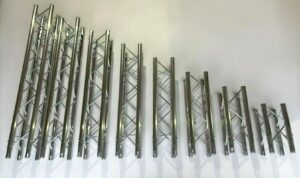
Aluminum truss has become a go-to choice for building structures in events, exhibitions, and modern design projects. It’s relied on for everything from stage lighting and sound rigs to custom retail displays, offering a strong, flexible, and polished framework that’s hard to beat.
This guide takes you through everything you need to know: what aluminum truss is, how truss systems work, the role of lighting truss, and the many applications for truss structures in different industries.
What Is Aluminum Truss?
Definition: Aluminum truss is a modular framework of tubes connected by welded joints, designed to bear loads and span distances.
Aluminum truss has 2 main components: chords and webbing. Chords are the main structural tubes that form the shape of the truss. Versatruss has 1” and 2” outside diameter chords. Webbing is the smaller tubes that connect the chords. Aluminum truss also requires connectors to join truss lengths together, ensuring stability.
Truss configurations:
- 2 chord ladder truss
- 3 chord triangular truss
- 4 chord box truss
Key advantages:
- High strength-to-weight ratio
- Corrosion-resistant, suitable for outdoor use
- Lightweight, making transport and setup easier
- Aesthetic, clean-line design for visible installations
Comparison: Aluminum Truss vs. Steel Truss
| Feature | Aluminum Truss | Steel Truss |
| Weight | Lightweight, easy to transport | Heavy, requires more labor |
| Corrosion Resistance | High (natural oxide layer) | Lower, requires coatings/maintenance |
| Strength | Excellent for modular builds | Very high, but overbuilt for many uses |
| Setup Speed | Fast, manageable by smaller teams | Slower, heavy-duty equipment often required |
| Best Use Cases | Events, exhibitions, retail, signage | Heavy construction, permanent installs |
Understanding Truss Systems
A single truss piece is only part of the story. When combined into systems, aluminum truss becomes a customizable structure adaptable to countless uses.
Common Truss System Configurations
- Straight runs – Basic horizontal spans (signs, banners, lighting).
- Truss Arch systems – Popular for entrances, stage surrounds, or trade show booths.
- Truss Booth – Four-sided, creating stronger cube-like assemblies.
- Tower systems – Vertical structures providing height for lighting and sound.
- Custom builds – Designed for unique event or architectural needs.
Lighting Truss Applications
Lighting is one of the primary reasons aluminum truss is used in event production. By raising and securing fixtures above the stage or floor, truss makes it possible to create professional lighting setups that are both safe and visually effective.
Key Uses:
- Concerts & Festivals: Rigging for moving lights, LED panels, and speaker arrays
- Corporate Events: Stage wash lighting, projection, and AV integration
- Trade Shows: Booth illumination and branded signage support
- Broadcast & Film: Mounting for cameras, studio lights, and sound equipment
Box truss is often the preferred choice for lighting since its four-sided design adds stability and allows for multiple rigging points.
Beyond Events: Truss Structures in Everyday Use
Aluminum truss isn’t limited to concerts and exhibitions. Its clean look and strength make it a favorite across industries:
- Retail Displays: Frameworks for product launches or seasonal promotions.
- Ninja Gyms: Create custom ninja structures that meet facility requirements for space; add different obstacles to the truss.
- Sports Facilities: Scoreboards, sponsor signage, and arena lighting.
- Outdoor Advertising: Stable frames for billboards, banners, and LED screens.
- Architecture: Decorative installations and support for custom features.
- Exhibitions & Trade Shows: Reusable booths that travel from city to city.
FAQs About Aluminum Truss Systems
1. How much weight can an aluminum truss hold?
It depends on size, shape, and configuration. A standard 12” box truss can often support several hundred pounds when properly rigged.
2. Can an aluminum truss be used outdoors?
Yes. Aluminum resists corrosion naturally, making it suitable for outdoor signage, festivals, and sports facilities. Our aluminum truss will not rust or corrode. Over time, you may notice it slightly oxidize (become cloudy looking). If this happens, using a very fine steel wool to buff it will bring back the shine and keep it looking new.
3. What sizes are available?
Common sizes include 10” and 12” truss, but manufacturers often provide custom builds.
4. Is the truss only for lighting?
No. Truss is used for signage, video walls, structural frames, exhibition booths, and even architectural design elements.
Final Thoughts
Aluminum truss systems are more than just structural supports; they are the backbone of modern staging, events, and architectural installations. Lightweight yet strong, modular yet durable, aluminum truss is the go-to solution for lighting designers, event planners, and builders who need both function and visual appeal.
By understanding the types of truss systems, the role of lighting truss, and the wide range of applications, you’ll be better equipped to choose the right setup for your project. Whether it’s an event entranceway, a trade show booth, or a permanent installation, aluminum truss provides the framework to make your vision possible.
